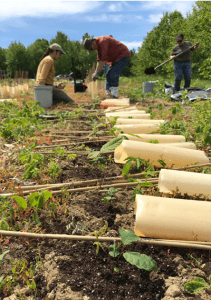Growing up I was fortunate enough to experience wild surviving American chestnut trees. I can recall with great clarity helping my grandfather pick nuts from their thorny burs as he searched for viable seeds for next season’s plantings, all the while occasionally sneaking one into my mouth. The sweet nuts found their way into various dishes and stuffing around the holidays, just as the thorns from the seed pods relentlessly found their way into my feet. As the importance of an individual tree species such as the American chestnut seemingly fades from the minds of many, how do we revive a sense of connection to the tree?

Unity College students mix potting soil for the planting of seeds at McKay Farm. Photo by Matthew Chatfield.
My admiration for the American chestnut was reignited upon taking a class in Conservation Biology at Unity College this past spring. It was here that I was first introduced to the seedlings planted in the Hartland Orchard. At the end of March 2019, the class assisted in planting 1,200 American chestnut seeds at the McKay Farm greenhouse in Thorndike. Knowing that only a handful of the trees from the thousands of seeds planted that day would make their way into the breeding program was impactful. Initially, for many of my peers, it would seem we are fighting a losing battle — one that requires a tremendous amount of dedication and time. After all, why should we focus so much time and energy into a single tree species? The answer lies in understanding the importance of the American chestnut within its ecological communities as a reliable yearly producer of hard mast, and how its absence in the native range permanently altered forest communities.

American chestnut seedlings after being planted at the Hartland Orchard. Photo by Matthew Chatfield.
When considering the goals of conservation biology, the importance of the American chestnut extends beyond its role in ecological communities, and takes root in human industry and culture. The light, rot-resistant wood that once commanded a large market, and highly palatable nut of the American chestnut, have long since been forgotten by most. In their place arises a new sense of human connection to this remarkable tree, a community dedicated to its conservation. Upon arriving at the Hartland Orchard, I was introduced to individuals from a wide array of backgrounds. College students majoring in chemistry and forestry, retired conservationists, individuals working in the medical profession, and grade school aged children simply enjoying getting their hands dirty; all brought together by a shared passion for chestnut conservation. We spent the day hoping to help reconstruct an ecological and cultural framework lost to blight. For hours we worked tirelessly; mixing soil, planting seedlings, and setting up barriers. Many hands made short work of a massive undertaking. As the day drew to a close, and the final trays of seedlings found their way into the soil, I looked out upon the hundreds of trees we planted. While only a tiny portion of a much larger picture, I couldn’t help but feel as if we are one step closer to the restoration of the American chestnut in the forests of Maine.
